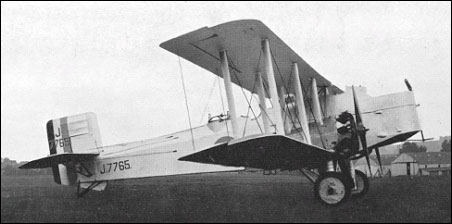|
| Specification 4/24 issued by the Air Ministry during 1924 called for the design of a heavily armed, twin-engined, night defence fighter, although the precise nature of the planned armament was not made known to the two companies that successfully tendered for prototype contracts, Westland and Bristol (with the Bagshot). Two prototypes of the Westland submission were ordered in 1925, and only late in that year was the armament specified as two 37mm Coventry Ordnance Works (COW) cannon, to be disposed in front and dorsal positions, plus a 7.7mm Lewis gun firing through a ventral hatch in the rear fuselage. Powered by a pair of uncowled 450hp Bristol Jupiter VI nine-cylinder radial engines, the Westbury - as the Westland fighter was duly named - was a three-bay biplane of mixed construction, combining a wooden wing with a fuselage of composite steel and wood, duralumin wing spars being introduced in the second prototype. Open cockpits were provided for the two gunners and the pilot, who was located ahead of the upper wing,
which attached directly to the deep fuselage. The nose COW gun was on a rotating mounting, and that in the aft cockpit fired forwards and upwards (aimed by the pilot). A second cockpit, to the rear, carried a 7.7mm Lewis gun on a Scarff ring, and the rear gunner also had the use of a second Lewis gun fired downwards through the entrance hatch. Flight testing of the Westbury began in September 1926, and the COW gun was successfully fired from both cockpits during later trials with the second aircraft, but no requirement was found for production of this category of fighter. The second prototype, as the Westbury II, was fitted with 480hp Jupiter VIII engines and had a rounded, rather than blunt, nose profile and aft-extended nacelle tails, features that were also introduced later on the first aircraft.
| WEIGHTS |
| Take-off weight | 3573 kg | 7877 lb |
| Empty weight | 2198 kg | 4846 lb |
| DIMENSIONS |
| Wingspan | 20.73 m | 68 ft 0 in |
| Length | 13.23 m | 43 ft 5 in |
| Height | 4.19 m | 14 ft 9 in |
| Wing area | 79.89 m2 | 859.93 sq ft |
| PERFORMANCE |
| Max. speed | 201 km/h | 125 mph |
| Ceiling | 6400 m | 21000 ft |
 | A three-view drawing (1212 x 775) |
| zhaoman, 20.06.2011 07:09 Jupiter VIII engines and had a rounded, rather than blunt, nose profile and aft-extended nacelle tails, features that were also introduced later on the first aircraft. reply |
|
Do you have any comments?
|
| 
COMPANY
PROFILE
All the World's Rotorcraft
|








